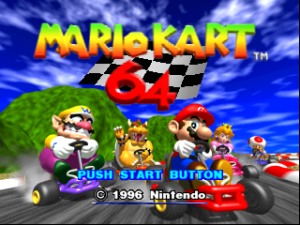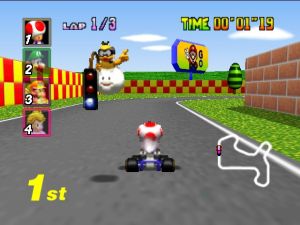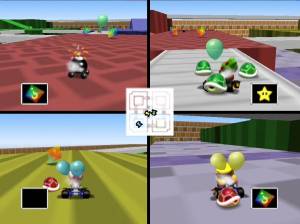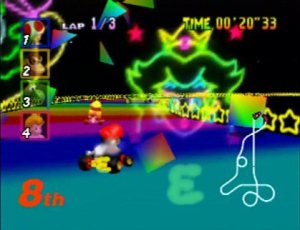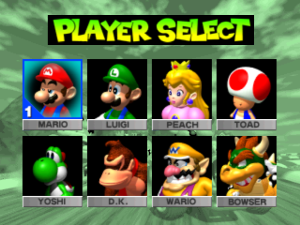Mario’s foray into the mobile gaming market has been interesting, to say the least. The first mobile Mario game, Super Mario Run, was released in 2016 to a lukewarm reception. It’s hard to imagine how things could have gone wrong, it’s Mario! And considering how well Pokemon translated to phones in the form of Pokemon Go, it’s all the more baffling (this also has to be the one and only instance in history where Pokemon was more fun than Mario). But the thing about the Super Mario series is that it isn’t just one series. Where Mario platformers go, Mario Kart is sure to follow. And sure enough, 2019 saw the release of Mario Kart Tour, the mobile iteration of Nintendo’s system-selling kart racer, which proved to be a record-breaking success for Nintendo. While Mario Kart Tour successfully translates the series’ fun gameplay to mobile phones, the game’s seemingly never-ending paywalls end up putting a damper on the experience.
It’s almost surprising how well Mario Kart works on a mobile device: the characters move automatically, as opposed to holding a button like the rest of the series. Though the feeling of having less control is a bit of a bummer, it ultimately makes sense considering this is the Mario Kart you play on your phone. You steer your character with the touchscreen, and use weapons by tapping said screen (some items can be sent forward or backward by swiping in those directions). Because steering and items both use the same mechanics, there are times when you may unintentionally use your item before you mean to, but for the most part, it actually works really well.
The race tracks rotate, based on biweekly events, which introduce multiple cups (comprised of three races and a bonus challenge). Most of the stages are from Mario Kart’s past, and come in different forms (some versions are just as they were in their original games, while there see different tweaks and variants as well), but there are also some new tracks based on real-world locations.
While the gameplay is, for the most part, classic Mario Kart (save for the tracks feature two laps, as opposed to the series’ standard of three), the thing that separates Mario Kart Tour from its predecessors is its emphasis on earning points.
In Mario Kart Tour, almost every action you make will nab you some points, whether it’s performing a drift boost, hitting an opponent with an item, jumping over bumps, and of course what place you finish the race in (both for the first lap and the race as a whole). Your total points will then be added up after a race, with every race course providing five possible Grand Stars depending on how many points you get.
Additionally, your placement will also award points to your player profile. Every time you gain another one-hundred percent, you’ll gain a level. With each subsequent level, you are awarded more points for your placements in races (though bad placements can knock your profile down a few points).
 Now, here’s where things get a little more strategic. You can gain yet even more points based on your selection of character, kart and glider, depending on the level. The level bonuses for characters are multiple items (some characters will get two items per box on certain stages, while a select few will get three. Get lucky and score three of the same item to enter “Frenzy Mode,” which grants temporary invincibility in addition to non-stop usage of whatever triple item you got for a short time). The level bonuses for karts are the amount of points you get per action (bottom tier characters receive the base amount, middle tier receive one-hundred and fifty percent, and top tier characters get two-hundred percent). Meanwhile, the level bonuses for gliders award for points for combos (chaining different actions consecutively with little pause).
Now, here’s where things get a little more strategic. You can gain yet even more points based on your selection of character, kart and glider, depending on the level. The level bonuses for characters are multiple items (some characters will get two items per box on certain stages, while a select few will get three. Get lucky and score three of the same item to enter “Frenzy Mode,” which grants temporary invincibility in addition to non-stop usage of whatever triple item you got for a short time). The level bonuses for karts are the amount of points you get per action (bottom tier characters receive the base amount, middle tier receive one-hundred and fifty percent, and top tier characters get two-hundred percent). Meanwhile, the level bonuses for gliders award for points for combos (chaining different actions consecutively with little pause).
Each character, kart and glider provides an added element independent of the selected stage as well: Some characters might have items that are exclusive to a select few, while certain karts might give you added points for specific actions, and gliders may provide a higher chance to get rarer items.
Things go another step further still, as you can level up characters, karts and gliders, which will give them a greater number of starting points, giving you a notable head start if your aiming for certain point goals. The more Grand Stars you manage to collect by reaching different point goals, the more you can unlock in the game.
Here is where things get aggravating, however: you are only allowed to level up characters, karts and gliders a certain amount every day. After you’ve earned a set number of experience points, you have to wait twenty-four hours before you can gain more (this is in relation to the characters, karts and gliders, you can still gain points for your profile, albeit much slower after you’ve maxed everything else out for the day). The daily cap also applies to coins, as you are only allowed to collect 300 coins in the races each day (though you can at least get more coins by completing specific achievements, which can even grant extra Grand Stars).
Now, the thing that makes this so bad is – as you may have guessed – the fact that you can ditch the daily limit if you subscribe to the game’s “Gold Pass” which, yes, costs real-life money. I mean, okay, you expect some form of micro transactions in free to purchase mobile games. But a whole subscription fee?
What’s worse, Nintendo has hidden additional features behind this paywall. Want to have the highest speed of 200CC races? You have to subscribe! Want to unlock characters and karts faster? Buy Rubies that you can use to launch a canon that unlocks something without the need of coins!
It’s…uhhh, not cool. To say the least.
To be fair, the game has recently introduced “Event Tokens,” green coins that show up on the racetracks in the second week of an event that you can use to unlock select characters and items, bypassing spending real money (or even the standard coins) on said items. So that’s nice, but it doesn’t change the fact that the game has too many paywalls to begin with. Look, I get that a company has to make money, so I’m not going to claim Nintendo is committing some kind of act of evil by finding ways to make profit off of a game that, again, you can download for free. But there comes a point when it just becomes too much. And Mario Kart Tour reaches that point. I feel bombarded with how often the game advertises something I can unlock if I’m willing to reach into my pocket. There’s a fine line between “wanting to make money” and just being greedy.
It’s because of the blatant greed why I feel tempted to rate Mario Kart Tour on the lower half of my grading system. But I feel like that would be dishonest, because I admit I’ve had a lot of fun with the game. I’ve been logging on night after night to level up my favorite characters and try to gain those Grand Stars that seem just out of reach. The game looks, sounds and plays great, and feels a lot closer to its console counterparts than other mobile installments in popular franchises (it may not be a patch on Mario Kart 8 Deluxe, but then again, what kart racer is?). I even hope the eventual Mario Kart 9 borrows some of its progression elements (not to the same excessive extent, of course. But it would be nice if Mario Kart could pull a rabbit from Crash Team Racing’s hat and allow players to unlock different character skins and the like by using a streamlined version of Tour’s leveling system. Hey, anything to prevent Pink Gold Peach from taking up a character slot). Mario Kart Tour is, for all intents and purposes, a terrific translation of Mario Kart onto mobile phones.
At least it is in regards to gameplay. But I’ve encountered panhandlers that don’t ask for my money as much as this game. It’s just a bit disheartening, really. Sure, Mario Kart on home consoles might be expensive, but at least once it’s purchased, you can play it and have fun until your heart’s content. But here you’re given a fun game, but are withheld from getting the most out of it unless you’re willing to dish out the dough.
The good news is what’s readily available in Mario Kart Tour is classic Mario Kart fun. Just be content with that and don’t fall for its trap.







